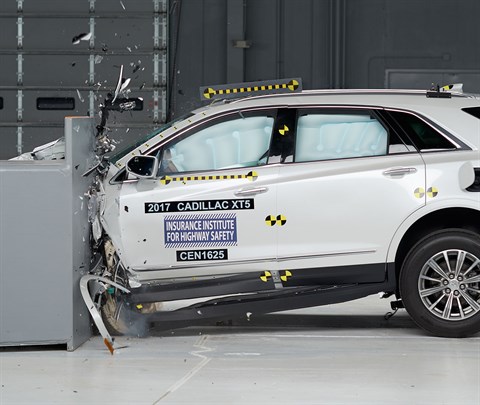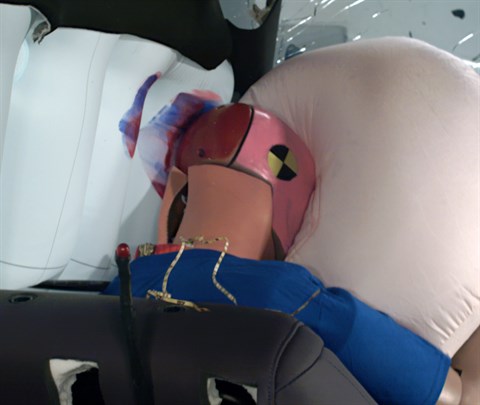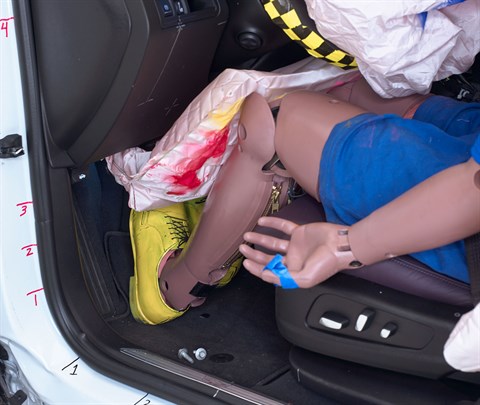Small overlap front
The small overlap front evaluation consists of a driver-side and a passenger-side component. This vehicle has an incomplete rating because it has been tested only on one side.
Driver-side
- Rating applies to 2017-25 models
Tested vehicle: 2017 Cadillac XT5 Luxury 4-door 4wd
The Cadillac XT5 was introduced in the 2017 model year. It is the replacement for the Cadillac SRX.
| Evaluation criteria | Rating |
|---|---|
| Overall driver-side evaluation | |
| Structure and safety cage | |
| Driver injury measures | |
| Head/neck | |
| Chest | |
| Hip/thigh | |
| Lower leg/foot | |
| Driver restraints and dummy kinematics | |

Action shot taken during the small overlap frontal crash test.

The dummy's position in relation to the door frame, steering wheel, and instrument panel after the crash test indicates that the driver's survival space was maintained very well.

The frontal and side curtain airbags worked well together to keep the head from coming close to any stiff structure or outside objects that could cause injury.

The driver's space was maintained well, and risk of injuries to the dummy's legs and feet was low.
Moderate overlap front: original test
Rating applies to 2017-25 models
Tested vehicle: 2017 Cadillac XT5 Premium Luxury 4-door 4wd
The Cadillac XT5 was introduced in the 2017 model year. It is the replacement for the Cadillac SRX. Moderate overlap frontal ratings are assigned by the Institute based on a test conducted by General Motors.
| Evaluation criteria | Rating |
|---|---|
| Overall evaluation | |
| Structure and safety cage | |
| Driver injury measures | |
| Head/neck | |
| Chest | |
| Leg/foot, left | |
| Leg/foot, right | |
| Driver restraints and dummy kinematics | |
Side: original test
Rating applies to 2017-25 models
Tested vehicle: 2017 Cadillac XT5 Luxury 4-door 4wd
The Cadillac XT5 was introduced in the 2017 model year. It is the replacement for the Cadillac SRX. Side ratings are assigned by the Institute based on a test conducted by General Motors.
| Evaluation criteria | Rating |
|---|---|
| Overall evaluation | |
| Structure and safety cage | |
| Driver injury measures | |
| Head/neck | |
| Torso | |
| Pelvis/leg | |
| Driver head protection | |
| Rear passenger injury measures | |
| Head/neck | |
| Torso | |
| Pelvis/leg | |
| Rear passenger head protection | |
Headlights
Trim level(s)
- All trims
| Evaluation criteria | Rating |
|---|---|
| Low-beam headlight type | LED projector |
| High-beam headlight type | LED projector |
| Curve-adaptive? | No |
| High-beam assist? | Yes |
|
Overall rating | |
| Distance at which headlights provide at least 5 lux illumination: | |
Low beams
On the straightaway, visibility was good on the left side of the road and fair on the right side. On curves, visibility was inadequate in all 4 tests.
The low beams never exceeded glare limits.
High beams
On the straightaway, visibility was inadequate on both sides of the road. On curves, visibility was inadequate in all 4 tests.
High-beam assist compensates for some limitations of this vehicle's low beams on the straightaway and all 4 curves.
